Genre: Action Developer: Imagineering Inc. Publisher: Absolute Entertainment Players: 1 Released: 1993
Video games based on movie licenses have a terrible reputation, and if you lived through the heyday of 8 and 16-bit gaming, you know exactly why that is. Though there are exceptions, these titles are almost always marked by poor gameplay, rushed programming, and a general and pervasive sense of half-assedness. (Back to the Future 3 is probably the most egregious example on the Genesis, since it shipped with a remarkably stupid bug that basically wrecked the game’s graphics.)
Toys: Let the Toy Wars Begin! is another entry in the long litany of movie tie-in games. It’s based on the 1992 film Toys, starring Robin Williams and Joan Cusack, which I haven’t seen but was apparently a box office disaster. The game was published by Absolute and released in 1993 on both the Genesis and SNES and seems to have been almost completely overlooked on both platforms. The development team included the legendary David Crane, the Activision wunderkind responsible for a slew of hits on the Atari 2600 including Pitfall!… and who turned out quite a few clunkers later on his career, like the rather dire David Crane’s Amazing Tennis. So, does Toys: Let the Toy Wars Begin! conform to the stereotype? Well, yes and no. It’s a flawed game that falls well short of what it could have been but has some novel ideas and creative gameplay.
Unlike many licenses, the premise of the movie seems reasonably well-suited for a video game. You play as Robin Williams’s character from the movie, Leslie Zevo, whose outfit may be one of the worst costumes ever seen in a video game: a powder-blue tuxedo jacket with tails, bright white shoes, and what look like red velvet sweatpants. Ugh. Your mission is to regain control of your late father’s toy factory from your power-mad uncle, Lt. General Leland Zevo, who has re-purposed the factory to make an army of dangerous killer toys. As you progress toward Leland’s command center, you collect an array of traditional “good” toys, like race cars and spinning tops, which can be used to combat the army of “bad” toys defending the factory.
One strange thing is that, as far as I can tell, nowhere in the game is there a single explicit reference to the movie. Neither the cover art, nor the manual, nor the game itself says anything about the film, not even to mention “Hey everybody, this is based on that movie with Robin Williams in it!” In fact, when I first started playing Toys, I had no idea it was a tie-in game until my girlfriend pointed out the connection. The only hint that it might have anything to do with a movie is a tiny copyright notice on one corner of the back cover. Since Toys (the movie) was a complete failure in the theaters, perhaps Absolute was trying to minimize guilt by association.
Toys has four levels, each of which is preceded by a short, goofy cut scene. The first three levels are played in an isometric/oblique perspective akin to Zombies Ate My Neighbors, a game that Toys resembles more than a little bit. You begin with a single weapon with unlimited ammunition, the Peanut Gun. It’s reasonably effective but isn’t very powerful, and since it fires in an arc, it can only hit targets that are a certain distance away. Thus, you’ll want to augment your arsenal as soon as possible with bowling balls, wind-up ducks, toy elephants, and any of the other dozen-plus items you can acquire. These are found on conveyor belts, food counters, or spinning turnstiles, depending on which level you’re in. When you get a new kind of toy you receive only a modest supply of it, but you can replenish your stock by picking up any of the gift boxes lying around the level.
Your main task in these first three levels is to destroy Leland’s security cameras. Each is guarded by a core group of three tanks, plus an additional slew of free-roaming “active defenders.” The tanks can’t be harmed until all the active defenders in that area have been eliminated, at which point all three tanks come chasing after you. There are also a slew of other enemies around to hassle you, like walking bombs and spiders. Leslie can take up to five hits before expiring, and a few life power-ups can be found tucked away in each level.
One interesting wrinkle is that enemy fire in this game is instantaneous, so there’s no way to dodge an attack from a tank or assault vehicle. You have to destroy them (or at least stun them) before they get their shot off, since their aim is generally deadly accurate. This adds an intriguing layer of tactical play. Since you can’t really afford a direct confrontation with enemies that have guns, you either have to hit them while they’re still offscreen or bait them into colliding with your good toys.
Once you’ve eliminated the defenders you face a first-person mini boss battle against the security cameras which, like your Peanut Gun, are in the shape of elephant heads. These can only be destroyed by unleashing a stream of water in their faces, first into their eyes (to blind them) and then their mouths (where the camera’s iris is). Meanwhile, the camera dodges to and fro to avoid your attack, counterattacking with laser beams if you let its eyes stay open for too long. This “Camera Combat” (as the manual calls it) must have seemed strange enough in 1993, but in our jaded, post-Rule 34 world it borders on the disturbing. Since the B button automatically directs your stream at the elephant’s mouth, though, the difficulty level is low and Leslie will almost always emerge unscathed.
The lameness of Camera Combat notwithstanding, Toys shows some real promise in these levels. Each toy has a distinctive pattern and personality, and once you get a feel for this, the strategy of the game becomes clear: keep Leslie out of danger and send out a massive armada to intercept your enemies before they get within striking distance. It’s actually pretty fun to unleash a torrent of different toys upon your foes, and since there’s more than enough ammunition to go around, you don’t have to be too painstaking about it. Sure, the game’s graphics and sound are fairly ordinary, but when you’ve got an army of twenty ducks doing your bidding, it’s easy to overlook such things.
After you clear the first three levels, you head for the final showdown with your uncle. This is where things go dramatically downhill, as the game trades in its isometric perspective for a side-scrolling trip through a scale replica of Manhattan. Here Leslie’s task is to cling onto the underside of a model plane, dodging swarms of aircraft and avoiding skyscrapers as he heads for the Command Center, while periodically flying through a Recharging Coil to keep his plane running. It’s almost always a bad sign when a game changes to a completely different style of play for its last stage, and Toys is no exception. Leslie and his plane are an oversized target and trying to navigate the narrow gaps between attacking aircraft is frustrating and annoying.
It’s tempting to see the hand of David Crane all over this stage, as it plays almost exactly like a cross between two of Activision’s Atari 2600 titles: River Raid (which Crane didn’t design), and Freeway (which he did). Indeed, the Recharging Coil is straight out of River Raid’s fuel depots and the frequent collisions with oncoming enemies amount to a horizontal version of Freeway.
Both of those games, however, are a lot more fun than this section of Toys. Fortunately, the game continues to offer a wealth of power-ups, though most of them blend in a little too well with the background scenery. I didn’t realize they were there until they were pointed out to me. However, this just makes the final level unsatisfyingly easy, without making it any less frustrating. It feels tacked-on and cheap, and leaves a bad taste in the player’s mouth at the end of the game.
The final verdict on Toys: Let The Toy Wars Begin! is that it’s a missed opportunity. In fact, the real tragedy of Toys is that with a few tweaks, it could’ve been a fantastic two-player game. The single-player mode wears thin after a while because barring the occasional cheap shot, the challenge isn’t really there, but the gameplay mechanic would be perfect for a battle mode. It’s a real lost opportunity. Despite the unpromising license, the pieces were in place to make this a real hidden gem, especially if the designers had added a two-player mode, which would’ve boosted the replay value tremendously. The folks behind the game clearly had some interesting ideas, but the gameplay itself simply isn’t compelling enough. As it stands, it’s a decent way to spend an hour or two, but there’s no real reason to pull Toys out again after you’ve beaten it.
SCORE: 5 out of 10

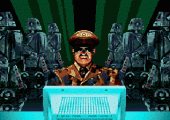
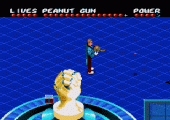
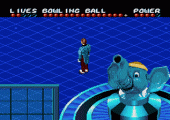
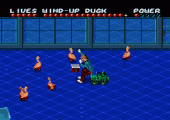
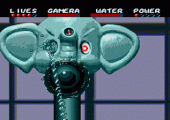
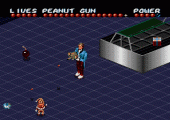

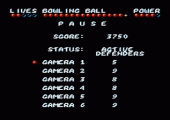
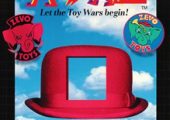
A couple updates/corrections:
(1) David Crane’s Amazing Tennis is far from “dire” — foolish comment on my part. The steep learning curve makes it seem disastrous at first, but it’s probably the best tennis game on the Genesis (and maybe on the SNES as well).
(2) The last stage actually resembles Stampede (bumping horizontal enemies) Barnstorming (flying through the barns/coils) as much as anything. No matter, it’s all a clear descendant of Activision games on the Atari VCS.
(3) I finally saw the movie with Robin Williams et al., and it’s an absolute trip, nothing like the feel-good pablum I was expecting. Unfortunately the beginning is poor and the climax is botched, but the middle is well worth seeing. I might write about it for the Reader Roundtable.